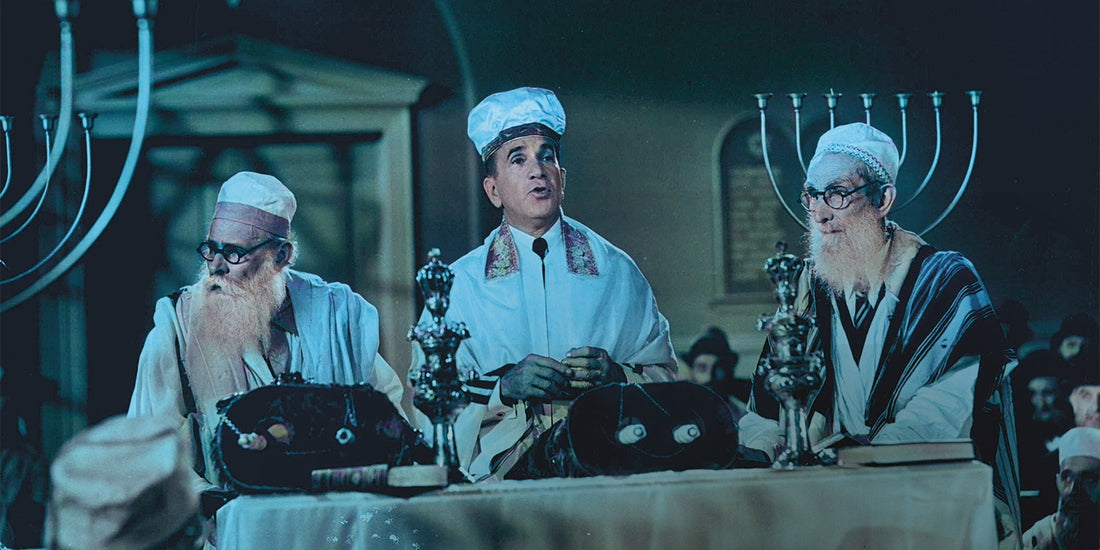
The Jewish service
Lively and rich in tradition
The Jewish service is a fascinating blend of ancient traditions, spoken and sung prayers, communal experience, and spiritual depth. It is a religious gathering where Jews pray, read from the Torah, and praise God.

The Jewish service - the where and how
Jewish worship usually takes place in a synagogue. However, it can also be held elsewhere if a so-called "minyan"—a quorum of ten Jewish adults—is present (traditionally ten men, but in liberal congregations, women are also included). The direction of prayer, in which the seating in a synagogue is usually arranged, is toward Jerusalem. Prayers are recited exclusively with heads covered. On the Sabbath and holidays, there are additional prayers and a more extensive liturgy.
Structure and procedure of the service
A typical Jewish service follows a fixed structure that has developed over centuries:
Opening and preparatory prayers
These are intended to prepare the worshipper internally for conversation with God.
Psukei D'Zimra (Psalms and Hymns)
A collection of texts from the Psalms that praise God's greatness.
Shema Israel
A central confession of the Jewish faith: “Hear, O Israel, the Lord is our God, the Lord is one.”
Amida (the “standing prayer”)
The heart of the service, in which personal and communal requests, praise and thanks are expressed.
Torah reading
Torah readings are given on certain days—on Shabbat morning and afternoon, as well as during morning prayers on Mondays and Thursdays. Torah readings also take place on holidays. The respective sections usually relate to the holiday or are thematically related.
Closing prayers
Prayers of thanksgiving and peace conclude the service.

Who leads the service? – Prayer leader, cantor, and rabbi
The prayer leader leads the congregation through the prayers and prays on their behalf. In Hebrew, the prayer leader is called the shaliach tsibur , which means "messenger of the congregation." Many prayers are recited alternately between the prayer leader and the congregation.
A prayer leader must be religious, reliable, memorized, and respected, but does not require formal training. In small or Orthodox congregations, the prayer leader is often spontaneously chosen from the congregation.
The cantor ( chazan , plural chasanim) is a prayer leader with professional training, e.g., at a Jewish seminary or conservatory. They have knowledge of music, liturgy, Hebrew, and often also of pedagogical skills.
A rabbi is primarily a religious scholar. His primary task is not to lead prayers, but to impart knowledge, advise congregants, and make decisions on religious matters. He has no specific liturgical role during services. However, a rabbi often assumes tasks during services, such as delivering a sermon. In these sermons, he explains important themes from the Torah or addresses current issues from a Jewish perspective. Sometimes the rabbi himself leads the service, especially in smaller congregations.

Music as the heart of prayer
Music plays a central role in Jewish worship, as many prayers are sung or recited in set melodies. It helps deepen the spiritual atmosphere, unites the congregation in communal singing, and brings the liturgical texts to life emotionally. Especially on Shabbat and holy days, the cantor contributes to the festive atmosphere with traditional melodies—often without instruments, as these are not used in the Orthodox rite on the day of rest.
Special services with rabbi and cantor
In services with rabbi and cantor, word and music, teaching and prayer merge into a particularly impressive religious experience.
-
The Shabbat service
When? Especially on Shabbat morning (Shacharit and Torah reading)
What? The cantor leads the prayers, sings psalms, the Kaddish, the Kedusha, and others. The rabbi delivers a sermon, comments on the Torah reading, and offers spiritual inspiration.
-
Services on Jewish holidays
When? On Rosh Hashanah, Yom Kippur, Pesach, Shavuot, and Sukkot, the services are particularly long and festive; on other holidays, too, there are sometimes special elements of the service.
What? The cantor performs special melodies (e.g., "Kol Nidre" on Yom Kippur), and the rabbi explains the meaning of the holidays, customs, and texts.
-
Services for special life events
When? For important occasions such as bar/bat mitzvahs, weddings, funerals or memorial services, anniversaries or honors
What? The rabbi and cantor jointly plan the ceremony. The rabbi delivers religious remarks, while the cantor provides the musical accompaniment.

Women and men in worship – different roles depending on the congregation
Depending on the branch of Judaism (Orthodox, Conservative, Liberal), there are different rules regarding the participation of men and women. In Orthodox congregations, men and women sit separately, while in Liberal synagogues, everyone prays together, and women can also act as prayer leaders or Torah readers.
